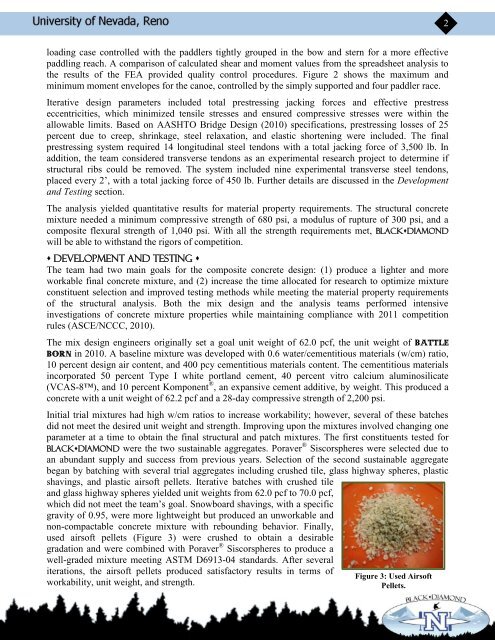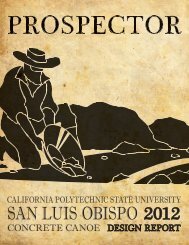Form Design Drawing - Concrete Canoe
Form Design Drawing - Concrete Canoe
Form Design Drawing - Concrete Canoe
Create successful ePaper yourself
Turn your PDF publications into a flip-book with our unique Google optimized e-Paper software.
loading case controlled with the paddlers tightly grouped in the bow and stern for a more effective<br />
paddling reach. A comparison of calculated shear and moment values from the spreadsheet analysis to<br />
the results of the FEA provided quality control procedures. Figure 2 shows the maximum and<br />
minimum moment envelopes for the canoe, controlled by the simply supported and four paddler race.<br />
Iterative design parameters included total prestressing jacking forces and effective prestress<br />
eccentricities, which minimized tensile stresses and ensured compressive stresses were within the<br />
allowable limits. Based on AASHTO Bridge <strong>Design</strong> (2010) specifications, prestressing losses of 25<br />
percent due to creep, shrinkage, steel relaxation, and elastic shortening were included. The final<br />
prestressing system required 14 longitudinal steel tendons with a total jacking force of 3,500 lb. In<br />
addition, the team considered transverse tendons as an experimental research project to determine if<br />
structural ribs could be removed. The system included nine experimental transverse steel tendons,<br />
placed every 2’, with a total jacking force of 450 lb. Further details are discussed in the Development<br />
and Testing section.<br />
The analysis yielded quantitative results for material property requirements. The structural concrete<br />
mixture needed a minimum compressive strength of 680 psi, a modulus of rupture of 300 psi, and a<br />
composite flexural strength of 1,040 psi. With all the strength requirements met, Black�Diamond<br />
will be able to withstand the rigors of competition.<br />
� Development and Testing �<br />
The team had two main goals for the composite concrete design: (1) produce a lighter and more<br />
workable final concrete mixture, and (2) increase the time allocated for research to optimize mixture<br />
constituent selection and improved testing methods while meeting the material property requirements<br />
of the structural analysis. Both the mix design and the analysis teams performed intensive<br />
investigations of concrete mixture properties while maintaining compliance with 2011 competition<br />
rules (ASCE/NCCC, 2010).<br />
The mix design engineers originally set a goal unit weight of 62.0 pcf, the unit weight of Battle<br />
Born in 2010. A baseline mixture was developed with 0.6 water/cementitious materials (w/cm) ratio,<br />
10 percent design air content, and 400 pcy cementitious materials content. The cementitious materials<br />
incorporated 50 percent Type I white portland cement, 40 percent vitro calcium aluminosilicate<br />
(VCAS-8), and 10 percent Komponent ® , an expansive cement additive, by weight. This produced a<br />
concrete with a unit weight of 62.2 pcf and a 28-day compressive strength of 2,200 psi.<br />
Initial trial mixtures had high w/cm ratios to increase workability; however, several of these batches<br />
did not meet the desired unit weight and strength. Improving upon the mixtures involved changing one<br />
parameter at a time to obtain the final structural and patch mixtures. The first constituents tested for<br />
Black�Diamond were the two sustainable aggregates. Poraver ® Siscorspheres were selected due to<br />
an abundant supply and success from previous years. Selection of the second sustainable aggregate<br />
began by batching with several trial aggregates including crushed tile, glass highway spheres, plastic<br />
shavings, and plastic airsoft pellets. Iterative batches with crushed tile<br />
and glass highway spheres yielded unit weights from 62.0 pcf to 70.0 pcf,<br />
which did not meet the team’s goal. Snowboard shavings, with a specific<br />
gravity of 0.95, were more lightweight but produced an unworkable and<br />
non-compactable concrete mixture with rebounding behavior. Finally,<br />
used airsoft pellets (Figure 3) were crushed to obtain a desirable<br />
gradation and were combined with Poraver ® Siscorspheres to produce a<br />
well-graded mixture meeting ASTM D6913-04 standards. After several<br />
iterations, the airsoft pellets produced satisfactory results in terms of<br />
workability, unit weight, and strength.<br />
Figure 3: Used Airsoft<br />
Pellets.<br />
2




